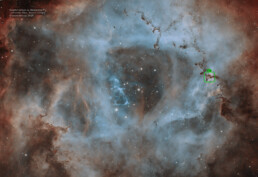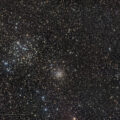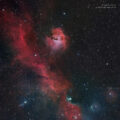The Rosette Nebula is a fantastic astrophotography target for most amateur setups. Smaller rigs can capture it in the rich context of Milky Way stars, while larger setups reveal its intricate structures and stunning details. This nebula with embedded open star cluster NGC 2244 is one of the real gems of the winter night sky. It lies in the Monoceros constellation between the Betelgeuse star of Orion and the Procyon star in Canis Minor. But you cannot see it with the naked eye – the telescope or larger binoculars are required to observe it visually.
The open star cluster NGC 2244, located at the center of the Rosette Nebula, is just 4 million years old – a baby by cosmic standards. Its hot, young stars produce strong stellar winds that push away gas and dust, sculpting the nebula’s central cavity and creating the iconic Rosette shape we see today.
The nebula shape is sometimes also referred to as the “Skull Nebula”. The Rosette Nebula complex is also known as the Caldwell 49 object, and it is present in the New General Catalogue (NGC) under several designations: NGC 2237, 2238, 2239, and 2246. It is located at a distance of 5,000 light-years from Earth and measures roughly 130 light-years in diameter.
NGC 2244 open cluster, was found in 1690 by English astronomer John Flamsteed. Then, in 1830, John Hershel discovered the first nebulous region – NGC 2239. Next was NGC 2238, discovered in 1864 by Albert Marth. Eventually, Lewis Swift discovered NGC 2237 in 1871 and NGC 2246 in 1885.
I captured this image from a suburban backyard using an 80mm refractor, an Ares-C color camera, and an L-eXtreme dual-band filter. The photo below shows an enlarged view of the Rosette Nebula’s center. The green frame highlights a region roughly 4 light-years across – the same distance that separates the Sun from Alpha Centauri, our closest stellar neighbor.
Image technical data: Date: March 2025 Location: Nieborowice, Poland Telescope: TS CF-APO 80/480 Corrector: FF/FR 0.8x Camera: PlayerOne Ares-C Mount: AM3 Exposures: L-eXtreme 250x2 minutes Conditions: Bortle 6, transparency and seeing medium, partially Moon





